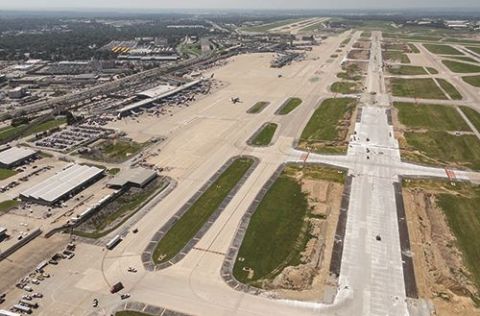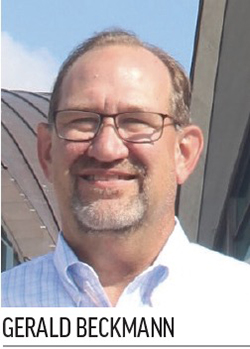Finish Line in Sight at St. Louis Lambert Int’l

A major rehabilitation of the main runway at St. Louis Lambert International Airport (STL) is nearing completion. Runway 12R-30L, which handles about 40% of the airport’s flight operations, is scheduled to reopen sometime in November after being closed for the last two construction seasons.
 The massive $85 million project involved tearing out and replacing large stretches of existing pavement that had reached its end of life; narrowing the width of the entire runway by 50 feet; and changing the geometry of several taxiways.
The massive $85 million project involved tearing out and replacing large stretches of existing pavement that had reached its end of life; narrowing the width of the entire runway by 50 feet; and changing the geometry of several taxiways.
The need for this project had been evident for several years, so airport officials had time to prepare for it. “We did a full reconstruction of the western third of this runway in 2012; and even back then, we knew we had to do the rest of the runway within 10 years or so,” states Gerald Beckmann, the airport’s deputy director for Planning and Development.
|
facts&figures Project: Runway Reconstruction Location: St. Louis Lambert Int’l Runway: 12R-30L Scope: Removing & replacing large sections of existing pavement; narrowing entire runway to 150 ft.; realigning & reconstructing intersecting taxiways Cost: $85 million Funding: 75% FAA Airport Improvement Program grants; 25% local match Project Management, Lead Design: Crawford, Murphy & Tilly Prime Contractor: Millstone Weber Construction Management: HR Green Construction Management: Kwame Building Group Signage & Lighting: Reinhold Electric Asphalt Shoulders: West Contracting Asbestos Cleanup & Disposal: Global Environmental Asbestos Testing: Professional Environmental Engineers Arresting Gear: Engineered Arresting Systems Corp. (now part of Curtiss-Wright) Pavement Removal & Drainage: Bloomsdale Excavating Striping: Tramar Contracting Landscaping: Site Systems Landscaping Key Benefits: Improved runway surface; all taxiways now align with runway at 90-degree angles; less maintenance cost due to decreased runway width |
This current project focuses on the eastern and middle sections of the critical runway. Planning how to perform the work as efficiently and cost-effectively as possible required a lot of coordination.
“In 2020 and 2021, we had many meetings with all the stakeholders, including the engineering firm, the construction manager, airlines, FBOs, Boeing and the FAA, among others,” Beckmann relates. “Eventually, we agreed to do this in two phases.”
Phase One was completed last year, from April to late September. Phase Two, which is expected to wrap up soon, started in March 2023.
Complex Project
The airport commissioned Crawford, Murphy & Tilly as the chief design and engineering firm for this endeavor. Project Manager/Chief Designer Angela Franklin and her team were responsible for construction, electrical, drainage work, etc. “This was a very complicated project,” says Franklin. “Usually, one of our design plans is about 150 pages long. This one ended up being 700 pages long. Basically, our team was overseeing several projects in one, including a runway reconstruction, a runway narrowing, several taxiway reconstruction projects and extensive electrical work.”
In addition to addressing the pavement condition, Crawford, Murphy & Tilly was instrumental in the airfield component of the airport’s master plan (led by WSP) to re-envision the preferred airfield configuration. This was largely driven by FAA’s recent changes in airfield geometric standards. The runway project was dependent on this comprehensive effort that involved engaging multiple stakeholders, evaluating several alternatives and then integrating FAA’s Safety Risk Management (SRM) Comparative Safety Assessment (CRA) process.
The FAA-approved plan was then turned over to the design team in October 2021, to incorporate the geometric changes affecting taxiways connected to the runway. The final design plan was completed by April 2022, just in time for construction. “We had five people working full time on this, and others part time, but we were able to complete the design process by our deadline,” Franklin reports.
Phase One, completed in fall 2022, consisted of reconstructing the center 3,500 feet of the runway, between taxiways R and L. It also involved reducing the width from 200 feet to 150 feet. The outer 50 feet of Runway 12R-30L that was ultimately to be removed remained in place during that first project.
Phase Two, which is almost complete, involves realigning several taxiways; reconstructing the eastern third of the runway; and narrowing the width of the entire runway from 200 feet to 150 feet. “Runway 12R-30L was rebuilt in 1960 to accommodate an aircraft fleet mix that no longer exists,” Beckmann explains. “Most airports no longer have such wide runways.”
Reducing the width of 12R-30L will, in turn, reduce overall pavement maintenance. In winter, it will reduce snow removal costs because crews will have a smaller footprint to clear.
The change also allows STL to adjust the geometry of every taxiway that intersects its busy main runway for better efficiency, safety and future growth. “When I joined Lambert in the 1980s, the taxiways were slanted,” Beckmann recalls. “Basically, we wanted to square up all the taxiways at a 90-degree angle to the main runway, especially in the busy middle zone. This mostly affected taxiways Q, P and E.”
These taxiways are being rebuilt with a 17-inch base of new concrete on a 6-inch drainable layer, all on a 22-inch recycled Portland Cement Concrete base.

Narrowing the runway and realigning several taxiways was an expensive and elaborate process, Franklin notes. “A lot of electrical infrastructure had to be rearranged. There were several thousand feet of electrical lines, and the airport’s main fiber-optic cable had to be moved or shifted. We also had to replace infrastructure related to pavement condition sensors, glycol collection system and NAVAIDs. We had to work with several airport departments along with the FAA to accomplish that.
“The signage and lighting on the airfield runway itself had to be moved or replaced,” she continues. “Fortunately, we have good electrical engineers on our staff who helped us with the routing and timetable for doing this.”
Asbestos in the Asphalt
One significant challenge was removing the asphalt layer that was between other layers of concrete. “Part of this airfield was built in the 1940s, and many overlay layers were added since then,” Franklin explains. “In the late 1960s to early 1970s, asphalt containing asbestos was used for the runway. When another layer was added in the 1980s, we had a sandwich situation. The base layer was made from 13 inches of concrete. The middle asphalt layer was about 8 inches thick. The top layer had 15 inches of concrete.”
Geo-testing and extensive core samples indicated that most of the middle asphalt layer contained asbestos. Prime contractor Millstone Weber was tasked with removing it.

“We were very careful to remove the top layer of concrete to expose the asphalt layer,” states Bob Leingang, the company’s senior vice president of Engineering and Estimating. “We are not a licensed asbestos waste disposal contractor, so a subcontractor was brought in to do that job. We used our equipment and trained personnel to assist in the removal and loading, but everything in this process was done under their supervision. The dump trucks get washed before and after the asbestos is loaded. Once the dump trucks are full, they are carefully wrapped to avoid any leakage into the air. The subcontractors continually used sensors around the work area to monitor the air.”
Trucks transported the asphalt that crews removed from the runway to a local landfill approved to accept special waste.
Arresting Cable
Boeing has a large presence at STL and uses its runways to test many types of aircraft for its own fleet and the U.S. Department of Defense.
“Boeing does a lot of testing of fighter jets here,” Beckmann specifies. “They are good about working around our commercial traffic. We usually know several days in advance when they are doing those test flights.”
To accommodate the military flight operations, STL has arresting gear at the ends of Runway 12R-30L and crosswind Runway 6-24. The cables, similar to those used on aircraft carriers, are embedded in the runway surfaces, and are only used for fighter jets, not commercial or private aircraft. Boeing communicates with the control tower to deploy the system as needed. The system on the east end needed to be replaced and upgraded as part of the runway reconstruction and narrowing.

Design and installation of the arresting cable was coordinated under the contracts of Crawford, Murphy & Tilly and Millstone Weber as part of the runway project. The contract also designated Engineered Arresting Systems Corporation (ESCO) as the system supplier. Millstone Weber operators worked with ESCO to install the system in the new runway pavement and ESCO was responsible for final testing. Boeing closely supervised the installation.
Jobsite Logistics
Maintaining aircraft operations during such a massive airfield construction was a key design factor in the phasing plan. Moving aircraft around the airfield has been a constant priority for the airport and contracting team while the main runway has been closed. Fortunately, the main alternate runway, 12L-30R, is 9,000 feet long and can accommodate nearly any aircraft that uses STL. “At first, we were a little worried that Lufthansa’s A-330s would not be able to operate on 12L-30R, but that has not been the case,” says Beckmann. “We also have had 747s land here that were diverted because of bad weather at other airports.”
STL’s crosswind runway, 6-24, also is being pressed into service more than usual, and the airport is keeping some taxiways open to provide access to the alternate runways.
Providing airfield access to the large number of workers needed for the runway and taxiway projects is a daily challenge. “All ground vehicles are escorted by airfield security to the work areas, and this is scheduled several weeks in advance,” Beckmann advises.
Millstone Weber coordinates the crews. “Every day, there is a lot of work going on at the same time. We simultaneously may have up to 100 workers on the airfield,” says Leingang. “We have to work closely with the airport and control tower concerning our daily schedule.”
 The contractor’s biggest equipment issue is getting enough trucks. “There is a huge demand for dump trucks in the St. Louis area,” Leingang explains. “We use up to 60 a day, and obtaining that many from hauling companies is a challenge. We have a full-time employee to coordinate just that.”
The contractor’s biggest equipment issue is getting enough trucks. “There is a huge demand for dump trucks in the St. Louis area,” Leingang explains. “We use up to 60 a day, and obtaining that many from hauling companies is a challenge. We have a full-time employee to coordinate just that.”
Fortunately, Millstone Weber has seasoned and experienced supervisors. “Our head supervisor has 35 years of experience,” says Leingang. “He and his staff communicate continually with the control tower if one of our trucks is crossing one of the taxiways. We are always very safety-conscious.”
Almost Done
In late August, Runway 12R-30L was on schedule to reopen in November.
“This project has obviously been an inconvenience for our clients, but I am confident that all of our customers will eventually agree that these changes will be worth it in the long run,” says Beckmann. “We will have a safer, more efficient airfield for many years to come.”
FREE Whitepaper
PAVIX: Proven Winner for All Airport Concrete Infrastructure
International Chem-Crete Corporation (ICC) manufactures and sells PAVIX, a unique line of crystalline waterproofing products that penetrate into the surface of cured concrete to fill and seal pores and capillary voids, creating a long lasting protective zone within the concrete substrate.
Once concrete is treated, water is prevented from penetrating through this protective zone and causing associated damage, such as freeze-thaw cracking, reinforcing steel corrosion, chloride ion penetration, and ASR related cracking.
This white paper discusses how the PAVIX CCC100 technology works and its applications.








